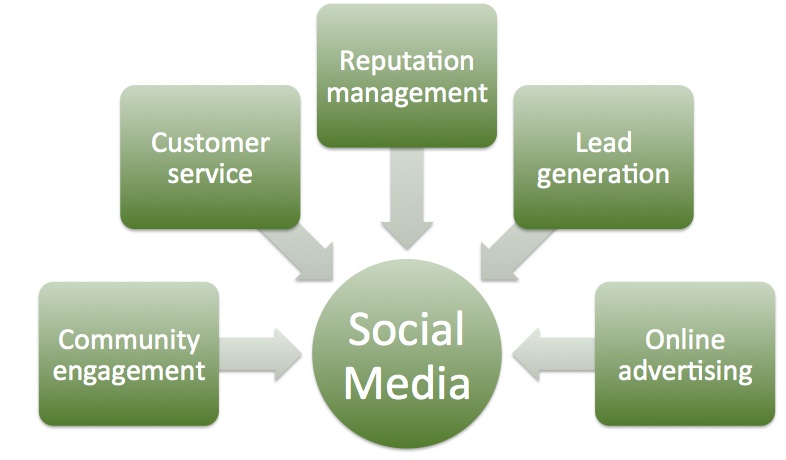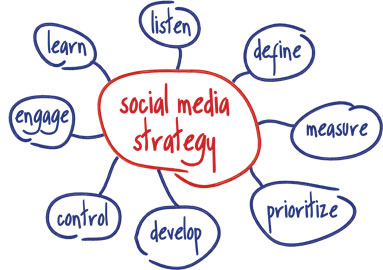
This is my point of view for the key elements of a Social Media Strategy, but also acknowledging that social media is not a stand alone digital strategy, it overlaps with online advertising.
I’ve just created a social media strategy for one of my clients, which I’m presenting to their board today, so I thought I’d share the process that I went through to determine what recommendations would be made, in terms of how they should proceed into the social media space. It’s important to acknowledge at this point that I am fortunate to work with a client who is prepared to invest in developing a strategy the right way. And by that I mean, not cutting corners.
Listen & Learn
As I’ve previous said in my eBook, The Essential Social Media Guide for Businesses Large & Small, a social media strategy should always start with Listening and Learning from what other businesses and brands are doing in the social media space (research). We started by researching the Industry my client operates in and understanding which of its members and competitors and retailers were active in this space and if they were active in social media, what were they talking to their communities about? This documented social media research was in the simple form of an excel spreadsheet that captured the Facebook Page locations, the Twitter handles and URLs, the LinkedIn location and YouTube channels as well as any profiles that these businesses had in Pinterest, Tumblr and Google Plus. This allows my client to easily benchmark what their competitors are doing in the social media space and go back at regular intervals to reassess their activity. Of course Parachute Digital encourages all brands to Like, follow and participate in their competitors communities because they can monitor what they are doing much more closely as well as to add value to the community by lending their considerable knowledge of their particular industry.
Competitive Analysis
We then invested in an Industry competitive analysis. This was not the same thing as looking internally at our direct competitors but more trying to learn how other industries and their businesses are participating in the social media space. Some Industries are far more committed to their social media engagement strategy than others. We were looking at several, opposing industries, trying to determine whether some industries saw it as mandatory to invest in the social media as an essential digital marketing channel or if it was a business or brand decision to investigate the opportunities a social media strategy can offer. We clearly saw that more highly emotional industries that engage directly with consumers and affect their everyday lives had a far stronger commitment to social media, as a customer service channel in many instances, than industries that had a more sporadic relationship with their direct customers (less frequent interactions).
While this was very interesting, there was no direct correlation with my client and their industry. So we were not able to establish a clear indication of how we should proceed in this space from looking at others, but we now had great examples from other industries of those who did it well and those who had entered into the space, but were only producing token broadcast style communications (which is not in the spirit of social media, nor does it represent much thought put into a social media strategy). What I have been saying since about 2007 and this research confirmed, is that social media is a long term strategy. Once you enter into this digital marketing channel, your business must be committed. Social media is not a set and forget channel. You cannot set up a profile and expect people to come and talk amongst themselves. Social media is about building a community and a relationship with the individuals within that community. This was blatantly obvious to us and we hope our client agrees.
Writing the Social Media Strategy
Now that we had all the research and competitive analysis under our belt, we felt far better equipped to make a recommendation to our client for their social media strategy. While the research didn’t spell it out plainly for us (that would be too easy, wouldn’t it), it did help us to clearly identify the essential social media channels that we wanted to launch our social media strategy. It also helped us better articulate how social media, as a digital strategy, will cross over with other digital marketing strategies, such as online advertising, social media advertising, email communications and website content strategies. We needed to be able to define the roles of our Industry and its members and how they can work together under a united social media strategy and not compete with one another. Looking at competitive industries was extremely helpful in showing how retailers and businesses dealing directly with consumers differed in their approach from associations and organisations who represented the Industry as a whole.
We have been able to provide many benefits for investing in the social media channel as a digital marketing strategy – and are pleased to report there are far more benefits for our client, than drawbacks. And its important to acknowledge the drawbacks of an approach in your social media strategy, as this risk assessment and contingency planning should be part of the scope of your social media strategy – especially if your’e recommending customer service as a critical element.
Like many digital marketing strategies, the Content strategy is the key element. Our industry research clearly defined the areas of interest for our clients’ potential community, we now need to create a content library (that will work across all digital marketing channels) and subsequent social media content plan to create a dialogue with our community and introduce these content categories in a helpful and informative way. Once we have our content plan in place, we can then launch our social media communities and start providing some values back to consumers.
This article was longer than I had expected it to be, and while I haven’t spelled it out for you when it comes to writing the actual social media strategy, I hope that the process has been useful and will help you start on your businesses social media strategy in the new year. Have a great day!

